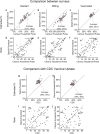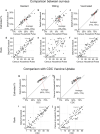Unrepresentative big surveys significantly overestimated US vaccine uptake
- PMID: 34880504
- PMCID: PMC8653636
- DOI: 10.1038/s41586-021-04198-4
Unrepresentative big surveys significantly overestimated US vaccine uptake
Abstract
Surveys are a crucial tool for understanding public opinion and behaviour, and their accuracy depends on maintaining statistical representativeness of their target populations by minimizing biases from all sources. Increasing data size shrinks confidence intervals but magnifies the effect of survey bias: an instance of the Big Data Paradox1. Here we demonstrate this paradox in estimates of first-dose COVID-19 vaccine uptake in US adults from 9 January to 19 May 2021 from two large surveys: Delphi-Facebook2,3 (about 250,000 responses per week) and Census Household Pulse4 (about 75,000 every two weeks). In May 2021, Delphi-Facebook overestimated uptake by 17 percentage points (14-20 percentage points with 5% benchmark imprecision) and Census Household Pulse by 14 (11-17 percentage points with 5% benchmark imprecision), compared to a retroactively updated benchmark the Centers for Disease Control and Prevention published on 26 May 2021. Moreover, their large sample sizes led to miniscule margins of error on the incorrect estimates. By contrast, an Axios-Ipsos online panel5 with about 1,000 responses per week following survey research best practices6 provided reliable estimates and uncertainty quantification. We decompose observed error using a recent analytic framework1 to explain the inaccuracy in the three surveys. We then analyse the implications for vaccine hesitancy and willingness. We show how a survey of 250,000 respondents can produce an estimate of the population mean that is no more accurate than an estimate from a simple random sample of size 10. Our central message is that data quality matters more than data quantity, and that compensating the former with the latter is a mathematically provable losing proposition.
© 2021. The Author(s), under exclusive licence to Springer Nature Limited.
Conflict of interest statement
The authors declare no competing interests.
Figures








Comment in
-
What surveys really say.Nature. 2021 Dec;600(7890):614-615. doi: 10.1038/d41586-021-03604-1. Nature. 2021. PMID: 34880485 No abstract available.
References
-
- Meng X-L. Statistical paradises and paradoxes in big data (I): Law of large populations, big data paradox, and the 2016 US presidential election. Ann. Appl. Stat. 2018;12:685–726. doi: 10.1214/18-AOAS1161SF. - DOI
-
- Barkay, N. et al. Weights and methodology brief for the COVID-19 Symptom Survey by University of Maryland and Carnegie Mellon University, in partnership with Facebook. Preprint at https://arxiv.org/abs/2009.14675 (2020).
-
- Kreuter F, et al. Partnering with Facebook on a university-based rapid turn-around global survey. Surv. Res. Methods. 2020;14:159–163.
-
- Fields, J. F. et al. Design and Operation of the 2020 Household Pulse Survey (U.S. Census Bureau, 2020).
-
- Jackson, C., Newall, M. & Yi, J. Axios Ipsos Coronavirus Index (2021).
Publication types
MeSH terms
Substances
LinkOut - more resources
Full Text Sources
Medical

